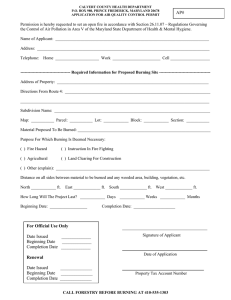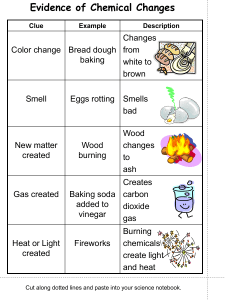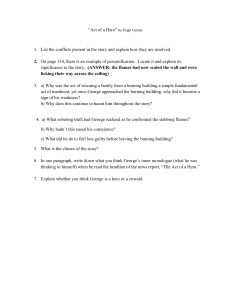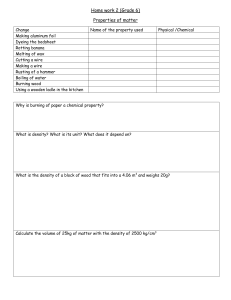Prescribed Burning & Air Quality Lesson Plan (Grades 10-12)
advertisement
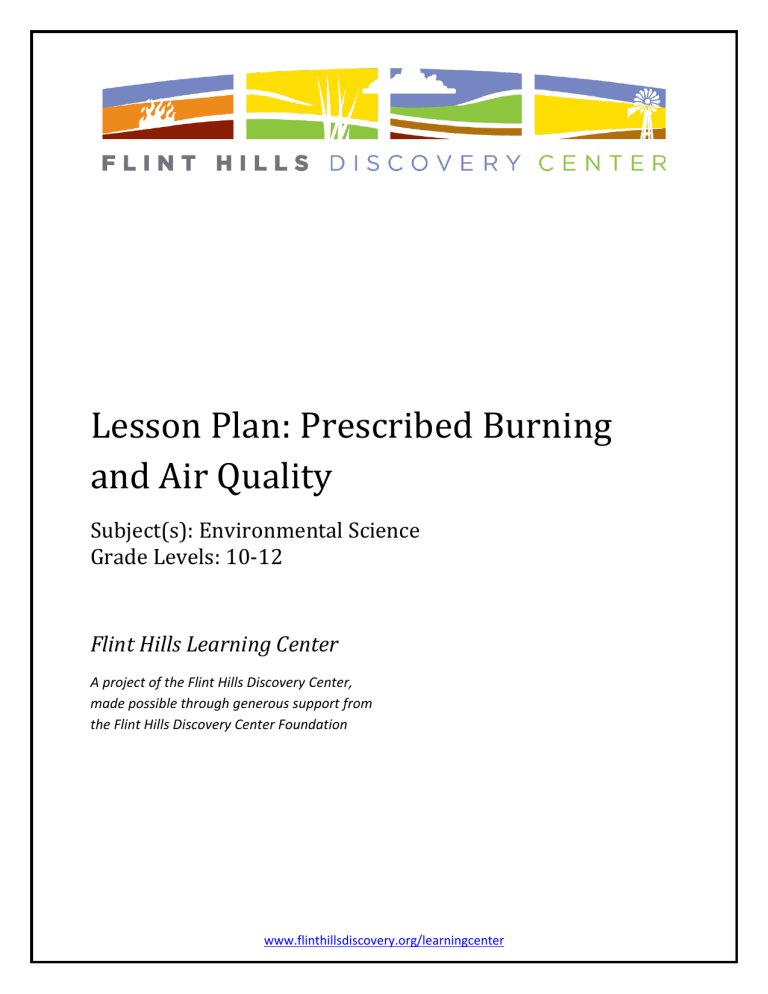
Lesson Plan: Prescribed Burning and Air Quality Subject(s): Environmental Science Grade Levels: 10-12 Flint Hills Learning Center A project of the Flint Hills Discovery Center, made possible through generous support from the Flint Hills Discovery Center Foundation www.flinthillsdiscovery.org/learningcenter Prescribed Burning and Air Quality Submitted by: Derick Budke, Science Instructor, Chase County High School, Cottonwood Falls, KS Subject: Environmental Science Grade Level: 10-12 Time: 45 minutes for 3 days - 1 hr/ week - suggested 3 weeks (Spring) Educational Standards: NGSS: HS-ETS1-3: Evaluate a solution to a complex real-world problem based on prioritized criteria and tradeoffs that account for a range of constraints, including cost, safety, reliability, and aesthetics as well as possible social, cultural and environmental impacts. RST.11-12.7 Integrate and evaluate multiple sources of information presented in diverse formats and media. RST.11-12.8 Evaluate the hypothesis, data, analysis, and conclusions in a science or technical text, verifying the data when possible and corroborating or challenging conclusions with other sources of information. Materials: Notecards or cardstock that can be cut into 2” x 2” squares. Small tub of petroleum jelly to be used for particulate capturing. String and hole punch to prepare the 2 x 2 squares for hanging. Proscope or other magnified photography device. 1 Grid acetate sheet / group. Or other device to equally divide up the picture of the collection sample. Overview: In this lesson students will be examining the amount of grass particulate matter in the air during the range burning season. Indoor and outdoor samples should be collected prior to and during the peak burning season. Students will be examining the essential question “Are range management regulations necessary to protect our air quality?” Objectives: 1. Students will research the practice of range management through controlled burning. (See Resources at end) 2. After this research students should be able to explain the benefits of managing controlled burning and why the practice is used. 3. Prior to burning season students can collect air samples using the sticky pads (2” x 2” petroleum jelly covered cardstock) from both indoor and outdoor locations. Each location should include a physical description and rationale. 1 Prescribed Burning and Air Quality 4. Model for the students the procedure for photographing and calculating particle collection density. 5. Students should be able to pick appropriate collection locations, and qualitatively and quantitatively describe the amount and types of particulates collected. (Good question for the class is: What is important to collect and how should it be recorded?) 6. Students should use their data to develop a conclusion about the amount of particulates in the air during burning season. 7. The final stage of the project is to create an argument using their data, their knowledge of the benefits of range management, and the regulations themselves to justify or discredit the regulation of controlled burning. Background Information: The background information about burning practices and regulations can be found in the web resources. You should review that material prior to beginning the discussion day 1. In order to complete this unit, students will need experience with both quantitative and qualitative data collection. Basic scientific investigation practices should be reinforced during the development of their collection models. Students will also need an introduction to the equipment (proscope, etc) that you will use to take the close up pictures of the samples (see attached sample pictures). In the past I have used an app called “Show Me.” I import the pictures, scale them, and give them a grid overlay and project them for class. The app allows me to write on the picture. This is particularly important when demonstrating for the students how to classify the size, type, and density of the particles. I like to ask the students at this point: What data is important to record about the samples? Answers include: a count of small, medium, and large particles, the overall number of particles, the density of particles in the sample (number of particles / square) etc. It is important to discuss what indoor and outdoor environment is appropriate to test. Locations I suggest are near doorways that open to the outside, near air handlers in the building, and outside in locations that have air movement but not a lot of direct sunlight (this tends to dry the samples out). Instructional Format: 1. Day one - Begin the unit with several questions about range management practices to gage your students understanding of the practice. a. Questions should include but not be limited to: Why do ranchers use controlled burns to manage their pastures. What are the benefits of these practices? Are there any disadvantages of controlled burns.? If so, what do you think they are? (Keep a record of the student responses for future use) 2. Day Two: Share the pasture burning practices (web pages 1,2,5) and have them prepare a blog, journal entry, or oral report of the benefits. (I typically use informal evaluation for these but do keep a list of the appropriate answers.) Have them present these to start the following day. 2 Prescribed Burning and Air Quality 3. Share the regulation information with them (web pages 3, 4) and have them prepare the same type of presentation about the regulations. 4. At the end of day two, introduce the essential question: Are range management regulations necessary to protect our air quality? Also, introduce the procedure for our sampling of the air quality. 5. Day three – Discuss the proper environments for collection and rationale for the locations (see resource page). Also introduce the procedure for examining and classifying the samples. 6. Next 3-4 weeks: The collection should take place 1 time a week under as similar weather conditions as possible for 3-4 consecutive weeks. You should start prior to burning season and work through the peak season. (Your local county agent is usually a big help determining the time frame). It will take about 10-15 minutes one class to put it out, and then 10-15 minutes the next class to take it down and take the photo. 7. Final Day: After completing the data collection students will formulate their opinions for their argument and presentation. Collection Procedures: 1. Record the weather condition (wind speed, direction, precipitation in the past 24 hrs, etc) and burning season status (no burning, heavy burning, light burning) 2. Prepare three to five sample cards and apply a thin smear of petroleum jelly. 3. Suspend the cards in different locations, splitting them between indoor and outdoor locations. 4. Allow the cards to hand for 24 hours before collecting them. (Be sure to not contaminate the samples) 5. Using a Proscope or other device, photograph the samples at a close enough range to view the trapped particles. 6. Analyze the pictures using a grid system. (See format) Conclusion: Question: Do we need to continue with controlled burning regulations? 3 Sample Daily data sheet Date: Wind Speed: Wind direction 24 hr Precipitation Burning Status Location _________________ _________________ _________________ _________________ _________________ Location Ration These two pictures represent the start of burning and a heavy burn day at the same location and similar conditions Picture www.flinthillsdiscovery.org/learningcenter Prescribed Burning and Air Quality Resources: Websites: http://thepioneerwoman.com/blog/2011/05/why-we-burn-our-pastures/ http://digitalcommons.unl.edu/cgi/viewcontent.cgi?article=1385&context=greatplainsquarterly http://www.ksfire.org/ http://www.ksfire.org/docs/regulations/April_Burn_Restrictions_030111.pdf http://files.dnr.state.mn.us/assistance/backyard/privatelandhabitat/benefits_prescribed_burning.pdf Konza Prairie: http://www.konza.ksu.edu/Splash/default.aspx Tallgrass Prairie National Preserve: www.nps.gov/tapr/ 1
